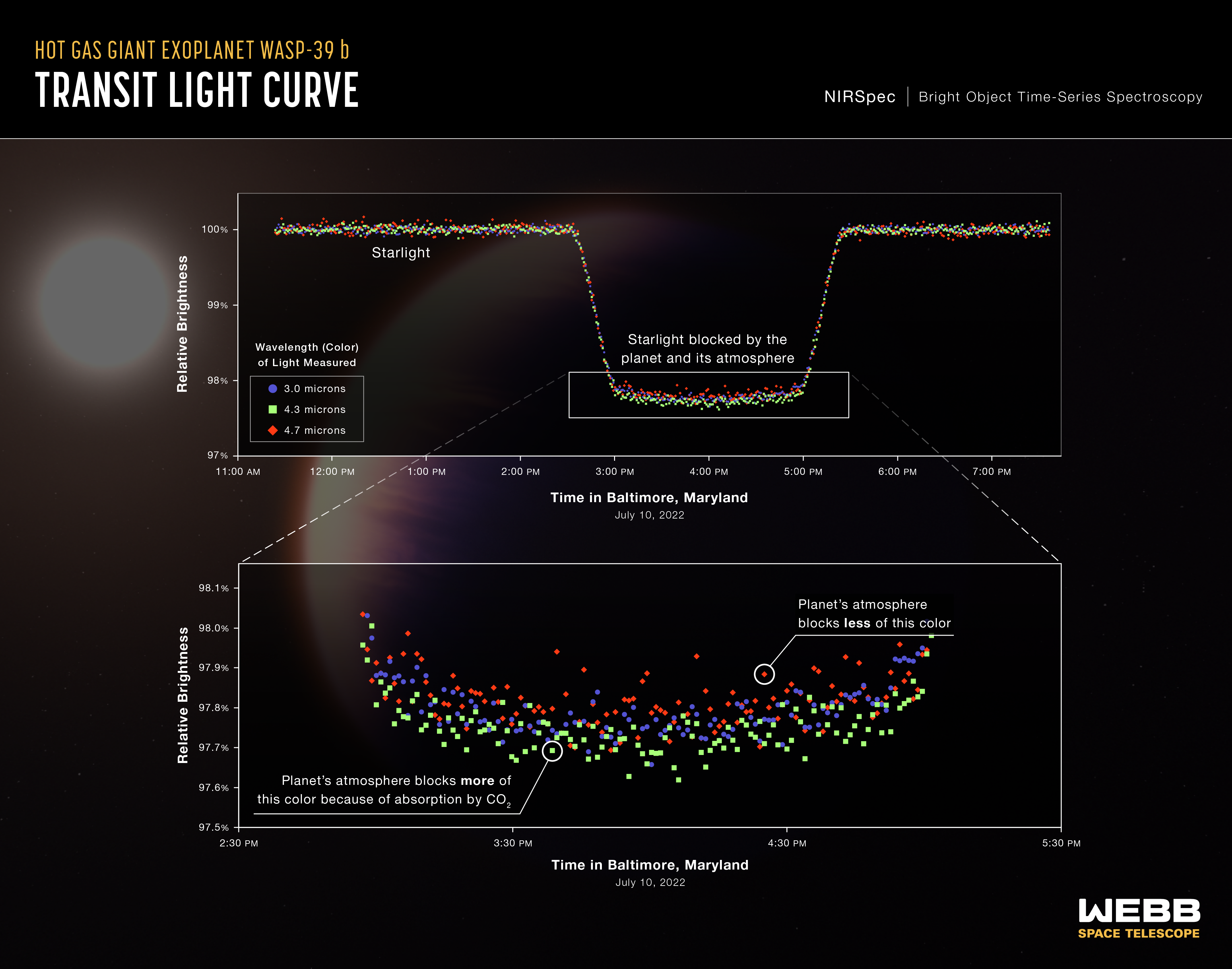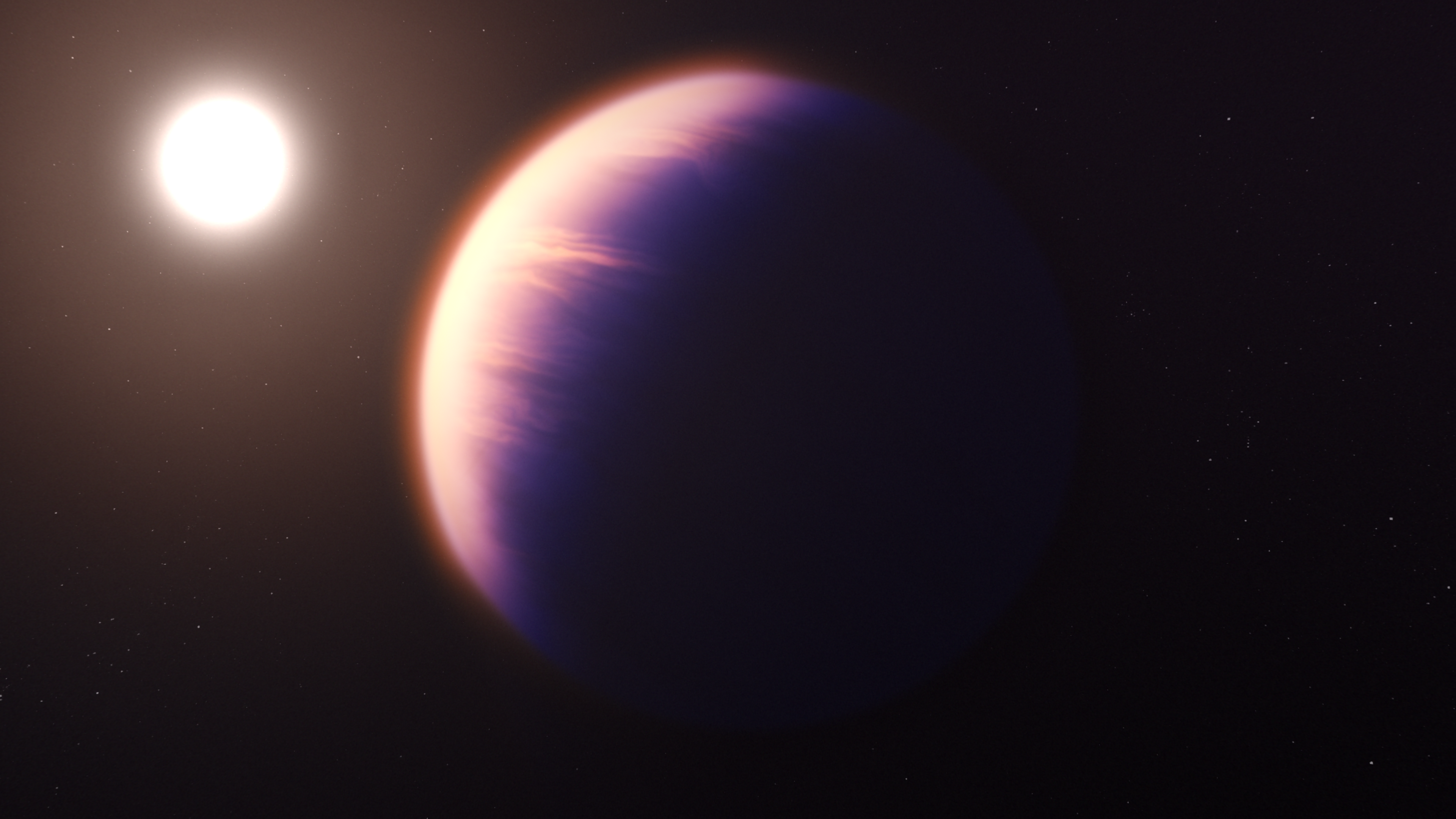1 min read
Exoplanet WASP-39 b (NIRSpec Transit Light Curves)

A series of light curves from Webb’s Near-Infrared Spectrograph (NIRSpec) shows the change in brightness of three different wavelengths (colors) of light from the WASP-39 star system over time as the planet transited the star on July 10, 2022. A transit occurs when an orbiting planet moves between the star and the telescope, blocking some of the light from the star.
This observation was made using the NIRSpec PRISM bright object time-series mode, which involves using a prism to spread out light from a single bright object (like the star WASP-39) and measure the brightness of each wavelength at set intervals of time.
To capture these data, Webb stared at the WASP-39 star system for more than eight hours, beginning about three hours before the transit and ending about two hours after the transit was complete. The transit itself lasted about three hours. Each curve shown here includes a total of 500 individual brightness measurements – about one per minute.
Although all colors are blocked to some extent by the planet, some colors are blocked more than others. This occurs because each gas in the atmosphere absorbs different amounts of specific wavelengths. As a result, each color has a slightly different light curve. During the transit of WASP-39 b, light with a wavelength of 4.3 microns is not as bright as 3.0-micron or 4.7-micron light because it is absorbed by carbon dioxide.
WASP-39 b is a hot gas giant exoplanet that orbits a Sun-like star roughly 700 light-years away, in the constellation Virgo. The planet orbits extremely close to its star (less than 1/20th the distance between Earth and the Sun) and completes one orbit in just over 4 Earth-days. The star, WASP-39, is roughly the same size, mass, temperature, and color as the Sun. The planet’s discovery, from ground-based observations, was announced in 2011.
The background illustration of WASP-39 b and its star is based on current understanding of the planet from Webb spectroscopy and previous ground- and space-based observations. Webb has not captured a direct image of the planet or its atmosphere.
About the Object
- R.A. PositionR.A. PositionRight ascension – analogous to longitude – is one component of an object's position.14:29:18.42
- Dec. PositionDec. PositionDeclination – analogous to latitude – is one component of an object's position.+03:26:40.2
- ConstellationConstellationOne of 88 recognized regions of the celestial sphere in which the object appears.Virgo
- DistanceDistanceThe physical distance from Earth to the astronomical object. Distances within our solar system are usually measured in Astronomical Units (AU). Distances between stars are usually measured in light-years. Interstellar distances can also be measured in parsecs.700 light-years
About the Data
- Data DescriptionData DescriptionProposal: A description of the observations, their scientific justification, and the links to the data available in the science archive.
Science Team: The astronomers who planned the observations and analyzed the data. "PI" refers to the Principal Investigator.This spectrum was created with data from Webb proposal 1366.
- InstrumentInstrumentThe science instrument used to produce the data.Near-Infrared Spectrograph (NIRSpec) PRISM, bright object time-series mode
- Exposure DatesExposure DatesThe date(s) that the telescope made its observations and the total exposure time.July 10, 2022
- Object NameObject NameA name or catalog number that astronomers use to identify an astronomical object.WASP-39 b
- Object DescriptionObject DescriptionThe type of astronomical object.Hot gas giant exoplanet
- Release DateAugust 25, 2022
- Science ReleaseNASA’s Webb Detects Carbon Dioxide in Exoplanet Atmosphere
- CreditIllustration: NASA, ESA, CSA, Leah Hustak (STScI), Joseph Olmsted (STScI)
Related Images & Videos

Exoplanet WASP-39 b and Its Star (Illustration)
This illustration shows what exoplanet WASP-39 b could look like, based on current understanding of the planet. WASP-39 b is a hot, puffy gas giant with a mass 0.28 times Jupiter (0.94 times Saturn) and a diameter 1.3 times greater than Jupiter, orbiting just 0.0486 astronomical...

Exoplanet WASP-39 b (NIRSpec Transmission Spectrum)
A transmission spectrum of the hot gas giant exoplanet WASP-39 b captured by Webb’s Near-Infrared Spectrograph (NIRSpec) on July 10, 2022, reveals the first clear evidence for carbon dioxide in a planet outside the solar system. This is also the first detailed exoplanet...
Share
Details
Laura Betz
NASA’s Goddard Space Flight Center
Greenbelt, Maryland
laura.e.betz@nasa.gov
NASA, ESA, CSA, Leah Hustak (STScI), Joseph Olmsted (STScI)






























